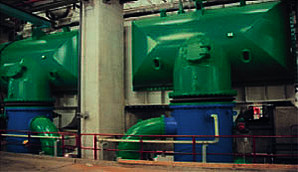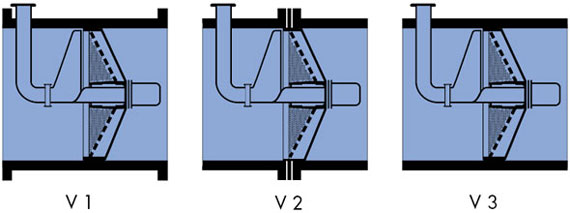High-Performance Debris Filter with individual Optimization Comfort
The PR-BW 800 is a High-Performance Backwash Filter for the separation of macro fouling (debris) from liquids. Main application is the filtration of cooling water in power stations and other major industrial water systems. With fineness degrees of approx. 5 - 9 mm, the filter eliminates macro fouling from large volume flows, even beyond 100,000 m3/h. In this way turbine condensers and heat exchangers installed downstream are effectively protected from macro fouling.
The outstanding features of the PR-BW 800 are its performance ratio that stands unparalleled to date, and its extraordinarily flexible adaptation capacities.
Operators’ demands for the individual optimization of process parameters are responded to by the TAPROGGE Filter Concept. Safe, comfortable, and on top performance level.

- Filter type PR-BW 800 in a power station
Field of Application:
Operation in seawater, brackish water, river water, or other water sources
- for the protection from macro fouling of objects installed downstream, such as condensers and heat exchangers, in open cooling circuits with once-through cooling or recirculative cooling systems (cooling towers)
- for the protection of water circuits of MSF seawater desalination plants from blockages caused by particle fouling
In standard design the filter consists of a filter housing with flanges on both sides which may directly be installed in-line, in an existing pipe. Depending on the pipe diameter the filter housing is divided into several chambers (1) by supporting steel sheets. Fixed in each chamber is a segment-shaped filter section (2) without gaps between inlet and outlet sides. According to requirements the filter elements are executed as perforated steel sheets, grids, Cling-Free© elements, or other special types.
Arranged at the inlet side of the filter is a backwash rotor (3) that, driven by a rotor actuation (7), can perform complete motions of rotation and even revert them, if necessary. The rotor is shaped as a hood that is adapted to the dimensions of the filter section. The rotor actuation (7) is mounted on the clean side of the filter section. Filter segments, rotor bearing and rotor actuation are firmly anchored to the bearing supporting sheets (5). The two radial sides of the rotor (3) are equipped with vortex inducers (6) that provide a hydraulic sealing of the relevant filter chamber when being covered. The rotor is connected to a debris discharge pipe (4). Installed in this discharge pipe is a debris discharge valve (11). A differential pressure measuring system (10) continuously monitors the fouling degree of the filter section.
The PR-BW 800 filter continuously removes all debris particles from the cooling water that would obstruct the heat exchangers and condensers installed downstream. In the filtration process the medium charged with particles flows through the inlet flange onto the segmented filter sections in the filter chambers. Particles that are larger than the selected filter fineness are retained in the bulky chambers on the relevant filter section.
With growing fouling the pressure differential at the filter segments increases until reaching a pre-set operational point. By the signal of the differential pressure measuring system, a timer, or via push button, the pressure-relieved backwash process of the filter is initiated. The backwash valve opens and the rotor drive is switched on, so that the backwash rotor successively covers each of the segmented filter sections in a circular motion. The cleaning of the individual filter segments is realized according to the principle of “pressure-relieved backwash”.
When the rotor hood covers a filter segment, a closed chamber is created. The drum-like turbulence resulting from the two vortex inducers ensures a hydraulic sealing chamber. Inflowing medium can no longer enter into this chamber. In consequence, the debris attached to the filter section is relieved from stagnation pressure. The debris particles to be filtered are thus relieved from pressure and can lift themselves off from the filter section.
By the opening of the discharge valve, the pressure differential prevailing between the filter and the end of the discharge pipe generates a reverse flow. In this way, even difficult types of fouling, such as fibrous debris, are literally threaded out of the filter perforation in the area that is covered by the backwash rotor. The backwash velocity that is rather low in the beginning prevents fibrous particles from being pressed against the rear sides of the filter segments, as is often the case in systems with spraying-off devices, for example.
Once pressure-relieved, all debris particles are seized by the backwash flow and washed out by the discharge pipe. The rotation speed of the backwash rotor can be adapted to local conditions. Upon complete rotation of the backwash rotor all filter segments have been cleaned by backwash. The backwash rotor switches off and the discharge valve closes.
Technical Data
| series: | PR-BW 800 |
| volume flow: | 1,800 - 100,000 m3/h and more |
| connecting diameters: | DN 800 - DN 3,600 |
| filter fineness degrees: | 5 - 9 mm |
| filter element: | perforated steel sheet or grid in stainless steel; Cling-Free© elements in plastic |
| material of housing: | steel, rubberlined |
| temperature: | max. 80 °C |
| control: | programmable controller |
| debris discharge capacity: | 2.5 ltr/m3 (depending on type of debris) |
| options: | safety valve, FilterOptimizer; Remote Monitoring Service |
| special execution: | on request |
Installation
The PR-BW 800 Debris Filter is normally installed directly upstream of the heat exchanger to be protected. The backwash process necessitates a pressure differential in the discharge pipe. Generally the discharge pipe of the filter can be arranged in a by-pass to the heat exchanger and re-fed into the cooling water flow downstream of the same, as the necessary pressure differential is caused by the heat exchanger itself. The backwash water can be discharged atmospherically by making use of the static overpressure downstream of the filter. If the pressure differential is insufficient, the backwash water can also be guided in a pipe via a booster pump.

- Filter type PR-BW 800 in backwash position
Technical Features and Benefits
Top-Level Performance
- The opposite graph shows the enormous performance potential of the PR-BW 800 that stands without parallel the world over. The filter has been designed for maximum debris discharge capacity.
- Perfect filter backwash by pressure-relieved, multiple-chamber system
- Due to its enormous performance ratio (debris discharge / time) the installation of a PR-BW 800 renders the further operation, installation, resp., of a travelling band screen arranged upstream unnecessary in many places.
- Low operational cost by small backwash water quantity, low pressure loss and little driving power
Comfort of Individual Adaptation and Optimization
- Optimization of filter media according to the type of debris: perforated steel sheet, grid, cling-free© elements, or other special executions
- Variable rotor speed offers adjustment to different debris loads
- Simple exchange of individual filter segments without filter disassembly; thereby flexible reaction on seasonal variations of debris (winter and summer operation) by quick exchange of filter section
- Individual selection of different installation versions: installation with complete housing shell (V1), in steel ring between existing flanges (V2), or on assembly ring for installation into existing pipe (V3).
- The filter is prefitted for the installation of the FilterOptimizer, the intelligent tool for the optimization of the backwash point.
Safety
- The excellent performance ratio is reflected in the quick discharge of abruptly occuring large debris quantities. The “worst case” can thus be mastered.
- Big and deep chambers avoid a blockage of the backwash rotor by huge debris particles; as a safety measure the direction of rotation is automatically reversed once an obstacle is encountered in a filter segment
- For extreme demands an integrated bypass solution is available
- Option: monitoring of filter operation by Remote Monitoring Service
TAPROGGE Care & Comfort Package
Quality right from the Start
- Performance by TAPROGGE as per DIN EN ISO 9001
- Safety of design by fulfilling the requirements of the European Pressure Equipment Directive 97/23/EC
- Application of a management system for safety, health and environmental protection (SCC)
- Standard documentation; documentation upon customer’s request, respectively
- The use of extremely corrosion-resistant materials with long lifetimes safeguards the preservation of the value of investment.
Compatibility by IN-TA-CT® Modules
- The PR-BW 800 filter is a modular element of IN-TA-CT®, our integral principle for the optimization of cooling water circuits.
- By combination with a TAPROGGE prescreening system upstream and a TAPROGGE tube cleaning system type D2 downstream, an effective overall solution according to IN-TA-CT®, our integral system, presents itself for the protection from micro and macro fouling. Without interfaces - and inclusive of the TAPROGGE System Guarantee.
Competence and Experience out of one Hand
- Application consultancy, project management, fabrication, installation and commissioning of the PR-BW 800 filters are available from TAPROGGE out of one hand.
- With more than 12,000 successful applications, TAPROGGE can make use of its application-technological experience in its special field that stands unparalleled the world over. This plus of competence is indispensable for difficult media and unknown cleaning behaviour.
- In addition to that, the cooling water test circuits of TAPROGGE’s Technological Centre allow a particularly reliable and cost-efficient simulation of site conditions.
Comprehensive Operator Support by IN-TA-S®
- By the installation and commissioning of the PR-BW 800 filters, operators have immediate access to IN-TA-S®.
- By IN-TA-S®, TAPROGGE takes care of the operator in all questions of operation and maintenance. Scope, duration and frequency of the care can be determined by the operator.
- Particularly quick support is available to the users of our Remote Monitoring Service.







